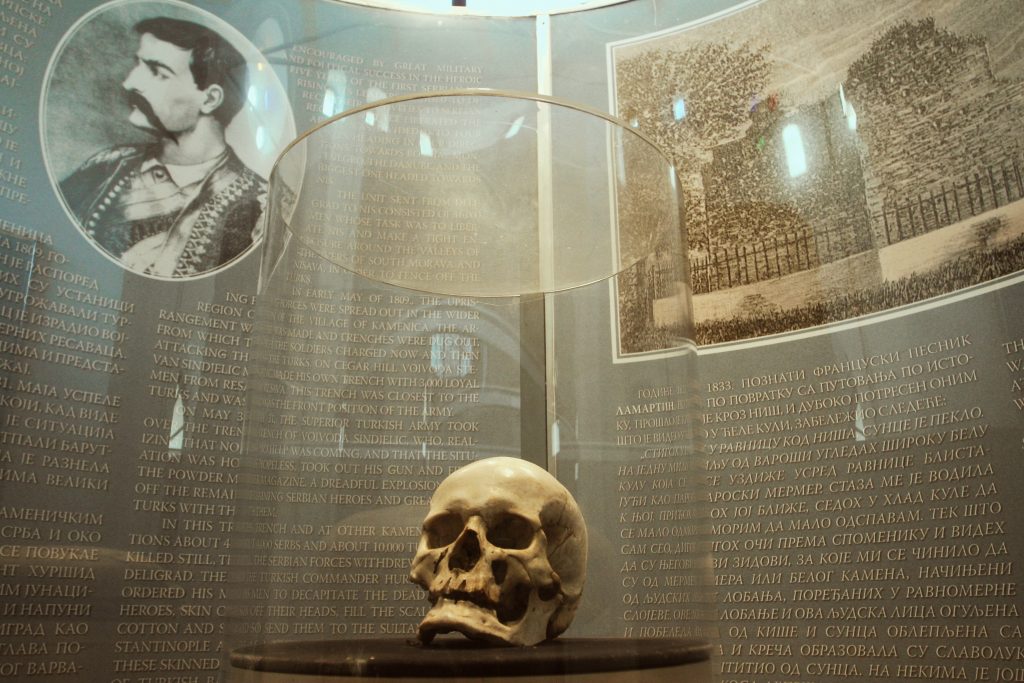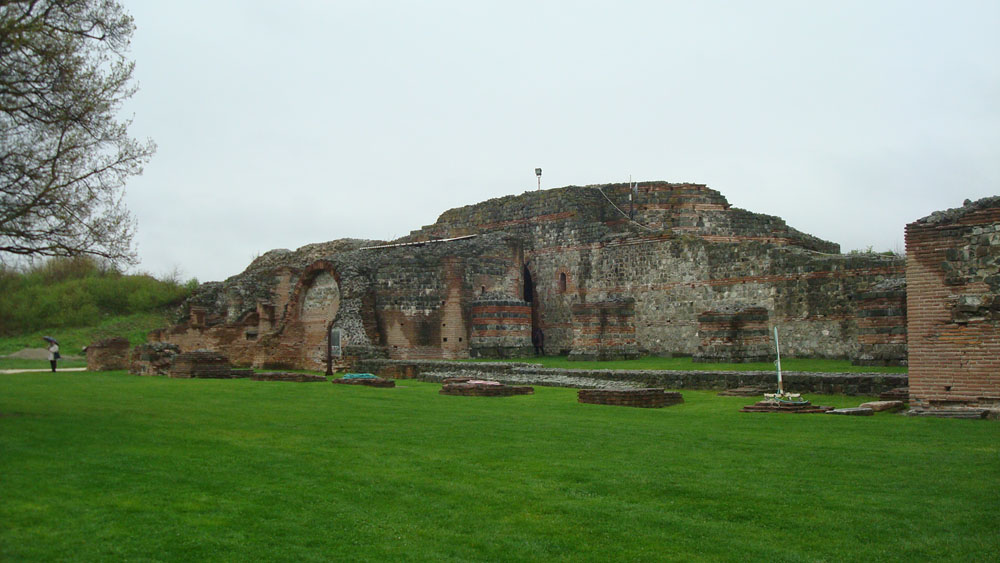Serbia – South and East (Niš, Požarevac, Smederevo, Pirot, Kladovo) May 26-27 2019
One sees Roma frequently: riding horse driven carts and their housing “districts” that look like squats – incredibly messy with garbage everywhere. They often beg with children on their hip, usually naked or unbelievably filthy.
NIŠ (pop 250,000)
Nis is the third largest city in Serbia and the administrative center of the Nišava District. Niš has long been a crossroads between East and West. Founded by the Celtic Scordisci in 279 BC, the city would serve as the birthplace of three Roman emperors: Constantine the Great, the first Christian emperor and the founder of Constantinople; Constantius III; and Justin I. Later playing a prominent role in the history of the Byzantine Empire, the city’s past would earn it the nickname The Emperor’s City.
After about 400 years of Ottoman rule, the city was liberated in 1878 and became part of the Principality of Serbia, though not without great bloodshed—remnants of which can be found throughout the city. Today, Niš is one of the most important economic centers in Serbia, especially in the electronics, mechanical engineering, textile, and tobacco industries. Constantine the Great Airport is Niš’s international airport.
Niš National Museum. This regional museum is primarily an archaeological museum showing the history of Nis from the Stone Age to the Romans plus the history of Nis through the Ottoman era. 200 SD
Niš Fortress. An original medieval fortress, the present fortress dates from the 18th century and the Ottomans. The great intact bastions front the Nišava River, but not much remains: part of a hamam from 1459-63 with 1m thick walls and archaeological digs from the ancient city of Naissus (thermae, ancient street, Byzantine street, Octagon Palace) with only fragments remaining. It is large – the sign said it was 22,000 hectares but I doubt that – 22 seems more reasonable and it is mostly a large treed park. Free
Holy Trinity Cathedral. Google Maps could not find this cathedral and I had to ask several people for directions (English is poor in this part of Serbia) and all writing is in Cyrillic so I could not be certain that the name was Holy Trinity. It is a great white plaster church dating from the 1850s with a 1937 bell tower and a large central dome surrounded by 4 smaller domes. The inside is completely frescoed in rich colours. The mammoth carved wood iconostasis with 48 icons is a highlight. Free
University of Niš building. In the NM “Modern Architecture Buildings” series, this 3-story Baroque building is triangular shaped. There were only offices on the ground floor and nothing special to see inside.
Monument of Stevan Sremac and Kalca. Stevan Sremac (1855-1906) was a academician and writer of Serbian realism literature and a secondary scjool teacher in Nis from 1879-1892. The monument is a small stone column with 4 fountain spouts in the middle of a small square. Near it is an intimate bronze statue with Sremac sitting at a small table talking to an older man while a dog watches.

Skull Tower is a stone structure embedded with human skulls located about 10kms east of Niš. It was constructed following the Battle of Čegar of May 1809, during the First Serbian Uprising. Serbian rebels under the command of Stevan Sinđelić were attacked by the Ottomans on Čegar Hill, near Niš. Knowing that he and his fighters would be impaled if captured, Sinđelić detonated a powder magazine within the rebel entrenchment, killing himself, his fellow rebels and the encroaching Ottoman soldiers. Vizier Hurshid Pasha ordered that a tower be made from the skulls of the fallen rebels. The tower is 4.5 metres (15 ft) high, and originally contained 952 skulls embedded on four sides in 14 rows.
Following the Ottoman withdrawal from Niš in 1878, the tower was roofed over, and in 1892 a chapel was built around it. In 1937, the chapel was renovated. A bust of Sinđelić was added the following year. In 1948, Skull Tower and the chapel enclosing it were declared Cultural Monuments of Exceptional Importance and came under the protection of the Socialist Republic of Serbia. Further renovation of the chapel occurred again in 1989.




As of 2013, 58 skulls remain on the tower. The one that is said to belong to Sinđelić is enclosed in a glass container. Seen as a symbol of independence by Serbs, the tower is mentioned in the writings of French Romantic poet Alphonse de Lamartine and English travel writer Alexander William Kinglake. In the two centuries since its construction, it has become a popular tourist attraction, visited by between 30,000 and 50,000 people annually
Zaječar National Museum, Zaječar. This regional museum covers the local history from the Bronze Age to the 20th century with special reference to Felix Romuliana. The museum has several sites: Radul bey’s Konak, Turkish Mill, Memorial House of Nefrola Pasic and Felix Romuliana. 300 SD
Gamzigrad-Romuliana, Palace of Galerius (Felix Romuliana). A World Heritage Site (2007), this massively fortified palatial complex Romuliana (Gamzigrad) was built for the Emperor Galerius’ mother Romila and perhaps for his own use, but it was never finished. Surrounded by a big wall with four 16-sided towers and sixteen 12-sided towers, there are the ruins of a luxurious imperial villa, temples and granary. Both mother and son are buried in mausolea on Magura ridge overlooking the site. Three early Byzantine churches from the 5th to the 7th centuries were also built but there is no evidence of them now. It was lived in during medieval times.
Galerius (305-311 AD) was born from a peasant family in Dacia Ripensis (Serbia) south of the Danube. He rose through the ranks of the army until appointed Caesaar in the first tetrarchy. On Docletian’s abdication he became Emperor and built an imperial palace-circus complex and a mausoleum in Thessoloniki, the imperial capital in Northern Greece. In the Danube corridor Galerius was a generous benefactor and built Felix Romuliana. He died near Serdica (Sofia Bulgaria) and was returned her for his burial. 300 SD

I then drove over 22 kms of a piece of shit road – 2-3m wide and more patch than pavement. You know it is bad when you don’t see another vehicle for the whole distance but pass two tractors pulling wagons. I did pass through a small village where all the houses had stone first stories and wood uppers to reach this place in the middle of nowhere.
Negotinske Pivnice (Pivnice Radosavljevic). A tentative WHS (15/04/2010), these are wine and vinegar cellars – at least 10 large stone buildings all with big arched doors. Many of them have marble plaques with Cyrillic writing and photos of people, the significance of which I don’t understand. There was a functional well with a bucket/windlass system.
An interesting sign for the Tourism Triathlon – Hike, Bike, Canoe from the Iron Gate to Gilden Har was here (the place seems to be on the route).

Bukovo Monastery. Unusually this church was closed (has sporadic opening days listed on the front). I have seen so many Serbian Orthodox Churches, I won’t miss seeing another. Enter a portal in a great bell tower and then under a arched entry that serves as the portal of the church. The church is small and not very high. I could see through some open windows – there were a few faded geometric paintings. The monastery surrounding it is a large white 4-story building.
Bor District northern panhandle (Kladovo). This is the most easterly part of Serbia.
Frontiers of the Roman Empire. A tentative WHS (09/04/2015), the fortified military frontier, limes, represented a barrier and protected the Roman Empire from the world of the barbarians. Ramparts, forts and military camps were positioned along this several thousand mile long frontier, stretching from Britain, along the Rhine and the Danube, to the Near East and Africa.
By establishing the provinces of Pannonia and Moesia in the 1st century AD, the limes were interconnected by a network of roads. Over time, settlements, some of which later developed into cities, formed around the fortifications. In addition to the strategically significant location of Pomoravlje (Morava River basin), particularly from the late third and during the entire fourth centuries, saw the development of large urban entities, such as Naissus (Niš), Sirmium (present day Sremska Mitrovica in the northern Serbian province of Vojvodina), and the Roman provincial capital of Viminacium plus a number of imperial residences and villas – Felix Romuliana, Sarkamen, Mediana and Justiniana Prima – and several forts and fortified frontiers.
Some historians believe as many as 18 Roman emperors originally came from towns that are now part of modern Serbia – the highest number of Roman rulers born in a single province outside Italy. The most important and well-known of the Roman emperors was Constantine the Great, who was born in present-day Nis. Constantine the Great was also one of the signatories of the famed Edict of Milan that gave Christianity equal status with other religions in the empire.
Diana. This was one of the limes on the Danube and one of the only sites that has much remaining. Today it consists of some foundations and low walls right on the Danube.
The road paralleled the Danube, a wide lazy river here (there must be a dam?). I crossed the river and entered Romania on a huge dam (Potile de Fier with locks on each side. There were no issues on crossing the border.
